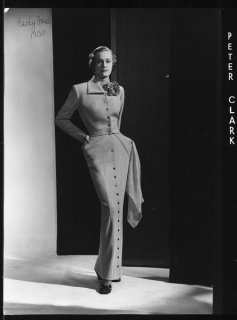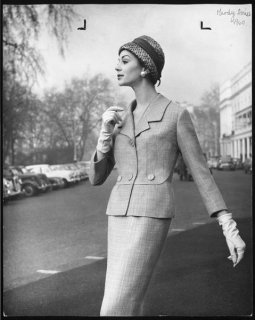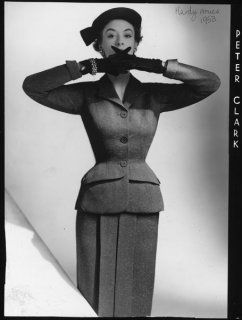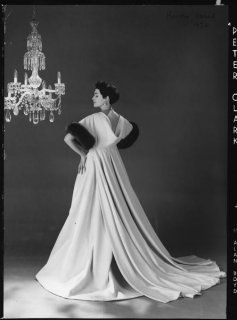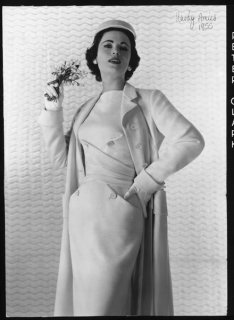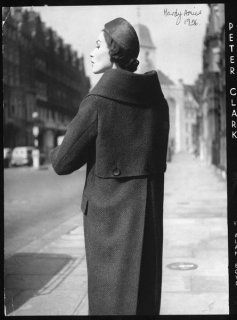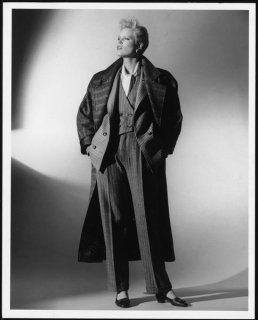SomethingElse
Press escape to continue.
- Joined
- Mar 22, 2007
- Messages
- 5,444
- Reaction score
- 0
His obituary from the Daily Telegraph in 2003, via 64-baker-street.org:
 Also see this wonderful site: http://www.hardyamies.com/books/brandbook06/HA_BRANDBOOK_06.pdf.
Also see this wonderful site: http://www.hardyamies.com/books/brandbook06/HA_BRANDBOOK_06.pdf. 
Sir Edwin Hardy Amies, who died yesterday aged 93, founded the most internationally successful couture house in Britain and was, from the time of her accession, dressmaker to the Queen.
Amies established the monarch's crisp, understated style of dress. "I don't think she feels chic clothes are friendly," he once told an interviewer. "The Queen's attitude is that she must always dress for the occasion - usually for a large mob of middle-class people towards whom she wishes to seem friendly."
He described his women's clothes as "sporty, expensive-looking and lady-like", adding, "Put the initials together and that's what they do - sell." He once claimed to design them mainly for the money, though he always insisted on the highest quality. A woman's day clothes "must look equally good at Salisbury Station as the Ritz bar", he said. "Our customer always has one foot in the country, one in the town." Among his other pronouncements was, "Scarlet should be left to the Alpine Rescue Squad." He was, though, much prouder of his men's fashions, which he brought to the mass market in the 1960s.
Yet Amies, a Savile Row couturier for more than 50 years, remained a traditionalist: in a letter to The Daily Telegraph in 1993 he wrote, "It is clear that the man's suit - an English invention, I must add - is still worn by men at all times when respect for tradition and hope for an ordered future prevail . . . The suit is the uniform of the gentleman."
He attributed his popularity overseas to the distinctively English elegance and nonchalance of his clothes, and rather enjoyed the indifferent attitude of his fellow countrymen to sartorial matters. "Even though it defeats me as a dressmaker, I admire the British attitude," he once said. "Clothes are not really as important as all that."
Edwin Hardy Amies was born at Maida Vale on July 17 1909; his father was an architect for the London County Council and his mother a vendeuse for a Court dressmaker in Bond Street. Young Hardy was educated at Latymer Upper School and Brentwood.
It was suggested that he should work for a scholarship to Cambridge, but Amies wanted to become a journalist. His father arranged for a meeting with R D Blumenfeld, the editor of the Daily Express, who told him: "We don't want academics in the journalistic world. We want men of international culture. Send him abroad to learn French and German. Make him work."
After spending three years in France and Germany - learning the languages and working for a customs agent, an English school and a wall-tile factory - Amies returned to England and became a weighing-machine salesman for W & T Avery.
It was Amies's facility with the written word that secured him his first job in fashion. His vivid description of a dress, written in a letter to a retired French fitter and brought to the attention of the owner of the Mayfair couture house Lachasse, made a strong impression. The wearer of the dress was the owner's wife.
In early 1934, with no previous experience, he succeeded the designer manager, Digby Morton, who had left Lachasse to set up his own house. Amies later said that many of his early designs were both hideous and extravagant, but in 1937 he scored a success with a tweed suit called "Panic". By the time war intervened, he was designing the whole collection.
During the Second World War, Amies joined the Belgian section of SOE as second-in-command to Lt-Col Claude Knight, whom he later succeeded in command. Working with the various Belgian Resistance groups, he organised sabotage and arranged for agents to be parachuted with radio equipment into the Ardennes. In his spare time, he slightly redesigned his lieutenant-colonel's uniform and had it made up by a civilian tailor.
On demobilisation, Amies bought the lease of a house in Savile Row, built by Lord Burlington in 1735 and damaged in the Blitz, and set up his own business.
He determined in the 1940s to get rid of his "suburban gaucherie" and learn the "lingo" and manners of the upper classes. He was, and remained, a self-proclaimed snob - indeed the snobbism was part of his charm: "I'm for elitism and its survival," he explained. "There's nothing wrong with it; it's usually benevolent and has good effects." At the same time, he was always the first to acknowledge his modest birth: "Not bad" he would say of his success, "for a suburban frock-maker."
It was not long before he was designing clothes for Princess Elizabeth. "A very grand lady asked me to make coats and skirts for what she called her 'gels' ", he recalled, "and they turned out to be ladies-in-waiting to Princess Elizabeth. The Princess saw them and asked me to make clothes for her visit to Canada in 1948." His royal warrant dated from her accession to the throne.
The Queen could not wear dark colours, he explained, because she would look in photographs as if she were in mourning; she chose not to wear beige because she thought people might not recognise her.
The Queen wore a Hardy Amies pink silk dress and coat for the Silver Jubilee and a Hardy Amies yellow coat on her 60th birthday. Less successful was the highly frilled and puffed Hardy Amies cream ballgown she wore to a state banquet held by the Reagans in 1983: the bows on its shoulders clashed with her spectacles.
In 1950, recognising a need for cheaper, instantly available clothes, Amies expanded his business by opening a ready-to-wear boutique, which now accounts for 50 per cent of the Savile Row trade.
In the late 1950s he designed his first man's shirt, and went on to become a consultant to Byfords (on socks and knitwear); Tootal (shirts, dressing gowns and pyjamas); Clarks (elastic-sided shoes); and Battersby Woodrow (soft felt hats). When he joined Hepworth's as a consultant, designing an annual collection worth £10 million, he declared that "my mission in life is to create a wardrobe for what I call the 'complete man' "; he and Hepworth's led the way in getting men's fashion accepted by the mass market.
Amies described himself as being realistic rather than romantic about fashion. "I am flattered that few of my garments are found in museums. They have all been worn out." He designed uniforms for the police, British Airways, the South African defence force, male nurses at Broadmoor and the staffs of W H Smith, the London Hilton and Wall's ice-cream.
Amies's new uniform for policemen in 1969 - a hacking jacket, slip-on shoes and narrow trousers - met with approval in the Force, but his designs were not always welcomed by British Airways' stewardesses: a 1967 outfit was scrapped because it was thought "frumpish".
In 1973 Amies sold his business to Debenhams, with a view to further expansion, but in 1980 bought it back with the profits of his success with menswear in Canada, Australia, Japan, America and New Zealand (where, he estimated in 1979, 55 per cent of men wore suits in whose design he had a hand). Eventually, he had more than 40 overseas licensees.
Amies had a waspish wit and his bon mots were eagerly awaited. "How scruffy you look today, dear boy," he might tell a young assistant: "I can't imagine what your underwear looks like." His rivals generally earned his sharpest gibes. "What are you wearing?" he asked one unfortunate journalist; "Armani, I suppose? Genitalia fastening! You can't have buttons below the waist."
Handsome, with aquiline features and a full head of hair, Amies was proud of his athletic figure and played tennis well into his eighties. His other principal love was gardening, and he built from scratch an elaborate traditional country garden at his home in Oxfordshire, a converted school house. He also enjoyed needlepoint, gros and petit point (though he never learned to sew), and had a passion for pictures of Stuart monarchs.
Amies never denied his homosexuality, though he did not flaunt it. He lived quietly with one man for 22 years but, when he went out socially, the lover remained at home: "It's just too common for two men to go around together," he explained. He was, though, proud of the fact that he never lost his eye for youth and beauty.
Amies was Chairman of the Incorporated Society of London Fashion Designers from 1959 to 1969. For a short period in the early 1990s he wrote a fashion column for Esquire magazine. He also published his autobiography in 1984, which even then was called Still Here. Looking back on his life, he concluded that one of the great advantages of modern life was that, with more bidets around, "my century has a cleaner bottom". His epitaph, he suggested, should read "He was a court dressmaker and an elitist with a sense of humour."
Hardy Amies was appointed CVO in 1977 and KCVO in 1989, by which time he had handed over the running of the couture house to Ken Fleetwood, his co-director in charge of design.
In 2000, Amies sold the house to the Luxury Brands Group and announced his formal retirement, although he hung up his scissors for good only last autumn.
 Also see this wonderful site: http://www.hardyamies.com/books/brandbook06/HA_BRANDBOOK_06.pdf.
Also see this wonderful site: http://www.hardyamies.com/books/brandbook06/HA_BRANDBOOK_06.pdf. 














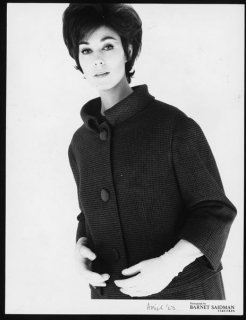
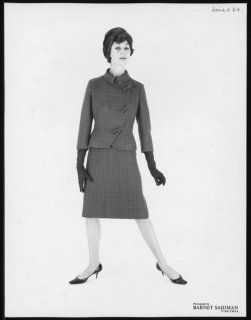
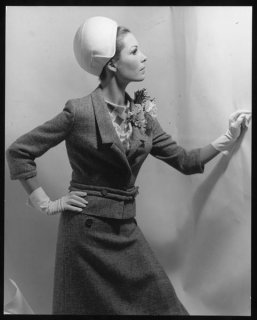
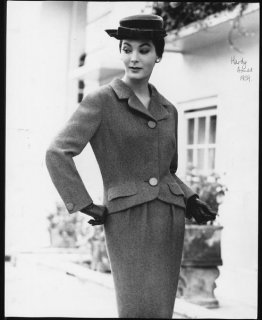
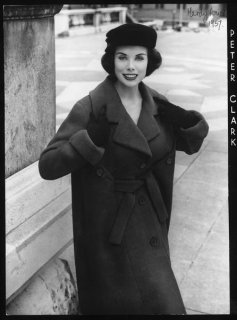
 eter Clark Ltd
eter Clark Ltd 